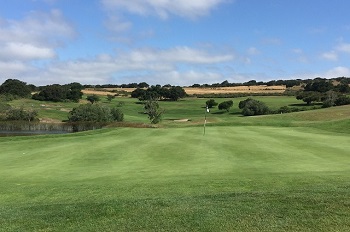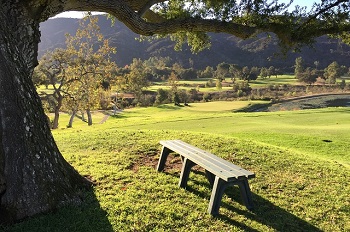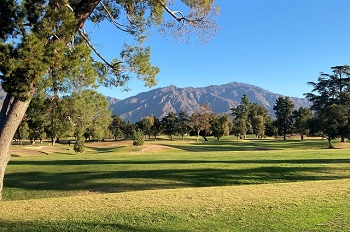URL copied to clipboard. Send it!
University Place, WA $149-$299
Chambers Bay Golf Course
A Touch of Scotland in the Pacific Northwest
 by Mark Holthoff | December 31, 2021
by Mark Holthoff | December 31, 2021

The view from the clubhouse at Chambers Bay.
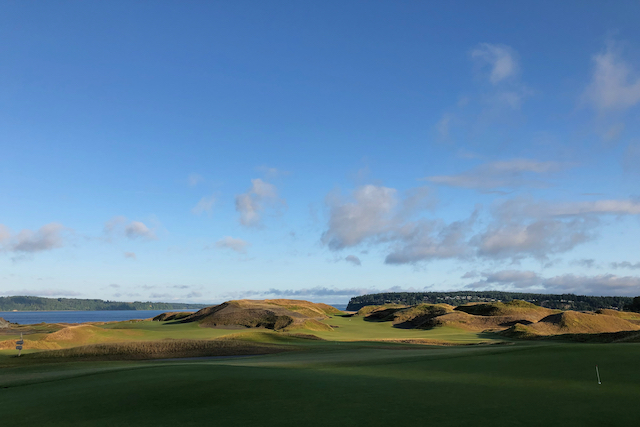
GG Rating
In 2007, Robert Trent Jones Jr. and his design partners, Bruce Charlton and Jay Blasi, transformed the former site of a sand and gravel mine into a modern links wonderland: Chambers Bay. This challenging course along the shores of picturesque Puget Sound features wide fairways, firm and fast turf, acres of sand, and large, undulating greens. It's a little slice of Scotland in the Pacific Northwest.
Pros & Cons
A true links golf experience, breathtaking views, strategic and varied layout, never a dull moment.
Pricey green fees, unpredictable weather, occasional slow play.
Chambers Bay is one the best links courses you can play this side of the Atlantic.
Intro to Chambers Bay Golf Course
When you're approaching Chambers Bay Golf Course, the setting may not look like anything special. But just wait. Located in a suburban neighborhood about 40 minutes south of the Seattle-Tacoma International Airport, the 18-hole public course doesn't fully reveal itself until you pull into the parking lot. And what a reveal it is.
You're greeted first by a sweeping view of Puget Sound — and if you're lucky enough to arrive on a clear day, the snow-capped peaks of the Olympic Mountains in the distance. Just beyond the parking lot, the land falls away sharply, bringing all 900 acres of the property into view: magnificent rolling turf and dunes stretching all the way to the water's edge. It's as if a small chunk of Scotland were suddenly teleported to your feet.
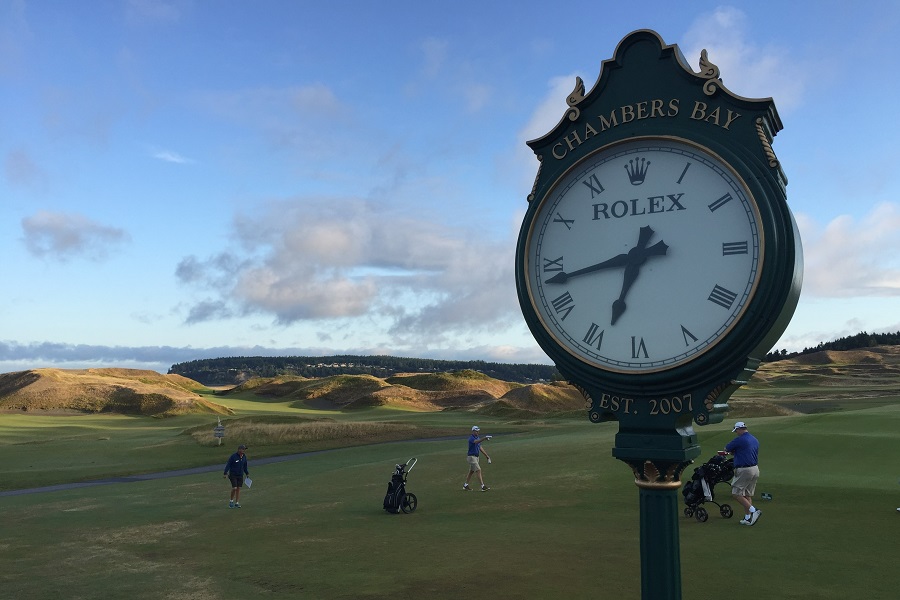
In a way, that's what happened. But instead of changing in an instant, the land was transformed slowly over decades. For years, a mining operation excavated sand and gravel from the site, creating a huge lumpy pit — something of an eyesore along the otherwise beautifully forested banks of Puget Sound.
Fortunately, local Pierce County officials saw its potential. After purchasing the property, they turned to the firm of legendary golf course architect Robert Trent Jones Jr. to design a world-class course befitting the location. And that they did.
Jones and his partners, Bruce Charlton and Jay Blasi, recognized the links-like nature of the former mine, with its seaside location and sandy terrain. Under their direction, crews removed, cleaned, and replaced over one million cubic yards of sand. In the process, they created massive dunes, which Jones and team used as a canvas for routing 18 highly varied holes.
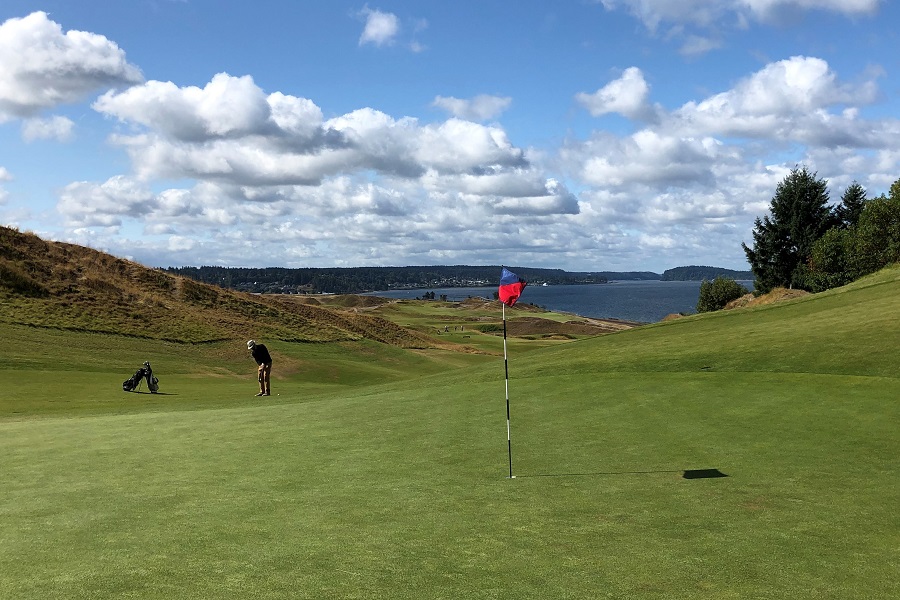
As with some of Scotland's most famous links courses, including St. Andrews, the course is bordered not only by water but also by train tracks and old-world industrial ruins, which add drama and visual interest to the round.
And like many links courses, it's walking only, so make sure to eat your Wheaties before you strap on your golf spikes. Or just grab a bite at the excellent on-site restaurant and bar.
Chambers Bay boasts not just 18 terrific holes of golf but also an award-winning practice facility with all-turf hitting areas as well as practice bunkers and greens for honing your short game prior to the round.
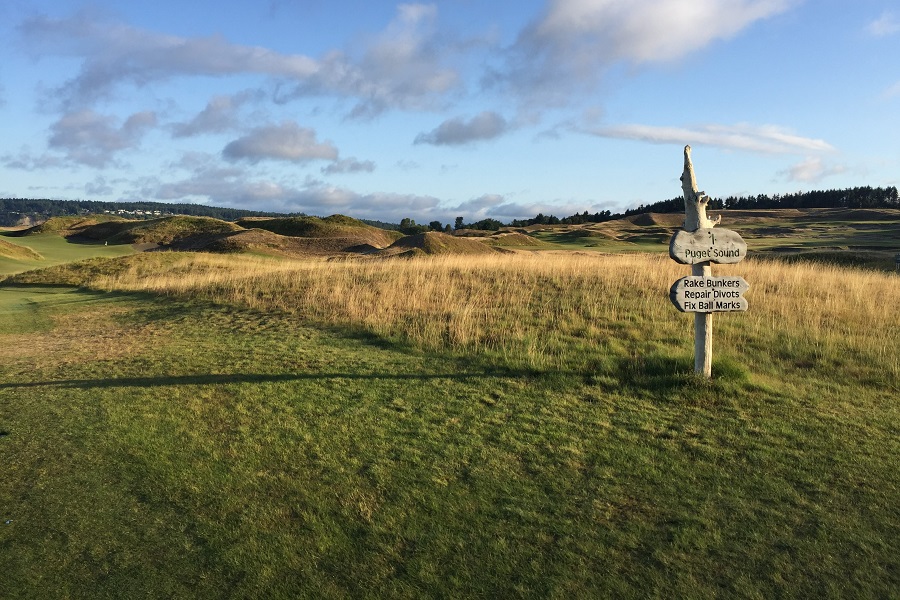
Playing Chambers Bay Golf Course
All distances below are from the Sand tees (6499 yards total).
With beautiful green turf and sandy dunes rolling off in all directions, it's easy to get a bit overhwelmed walking to the opening tee. Fortunately, the 501-yard par-5 first hole offers a relatively calm start to the outward nine. A large fairway awaits — as does a sizable bunker for drives pushed right. On your approach, favor the right-hand side as everything left falls away sharply, leaving a tough third into the narrow green.
The par-4 second hole (365 yards) is also rather mild. But lay back off the tee, if necessary, to keep from reaching the large sandy area on the left side of the fairway, which begins about 100 yards from the green. The green itself provides much of the challenge on this hole. A ridge bisects the surface into two distinct halves, so your approach needs to be precise to avoid a three putt (or worse).
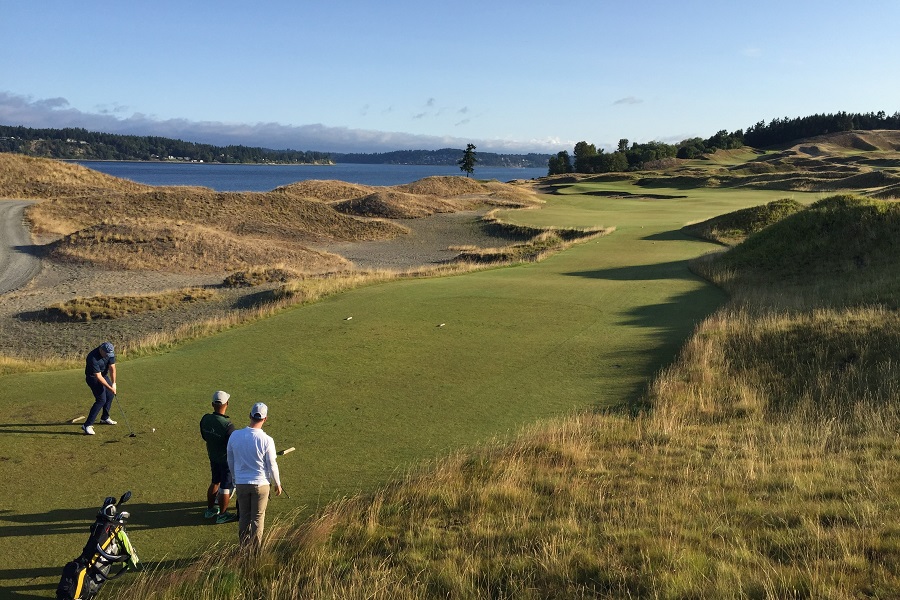
The third hole (145 yards) is the first par three of the round. With a gaping bunker protecting the green short and left, the smart play is to the right-hand side, where a slope tends to kick the ball back to the center of the putting surface.
The course starts to show its teeth on the 530-yard fourth hole, a challenging uphill par-5. As it climbs away from Puget Sound, the hole swings right. Choose your line carefully because a massive bunker complex inside the dogleg awaits shots that fail to carry. The left edge of the green is a good target for your approach; a slope there funnels the ball toward the middle.
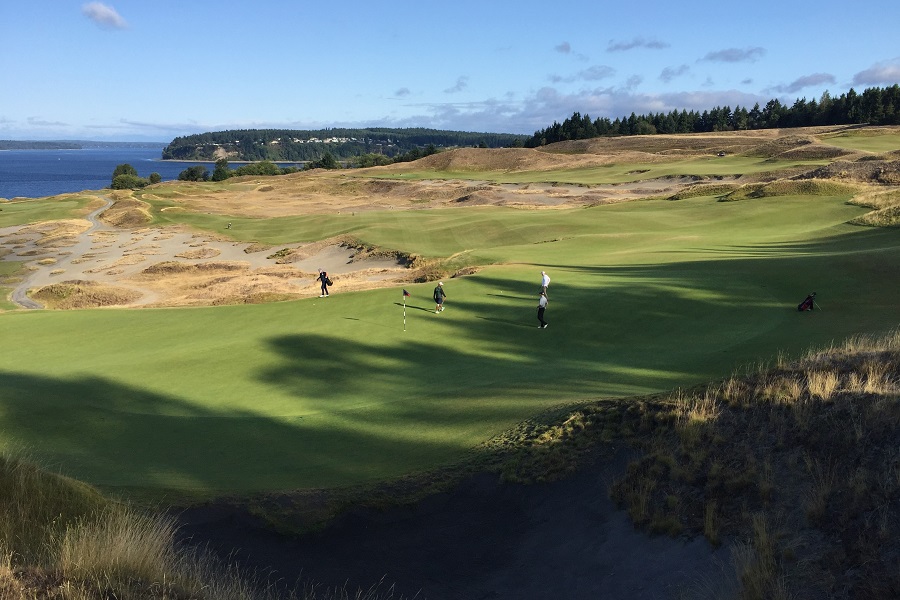
The par-4 fifth hole (441 yards) plays back down the slope, inviting you to launch a drive from the elevated tee. But don't get too carried away. Bunkers begin to pinch the fairway about 250 yards out. That may leave a lengthy shot home, but you can play your approach as a run-up to either left or right of the small pot bunker directly in front of the green.
The par-4 sixth hole (369 yards) seems relatively tame from the tee. A 220-yard poke to the left-hand side of the fairway sets up the best angle for the approach. From there, though, things get tougher. The narrow green, nestled between massive dunes, is easy to miss, and bunkers gobble up anything left, right, or short.
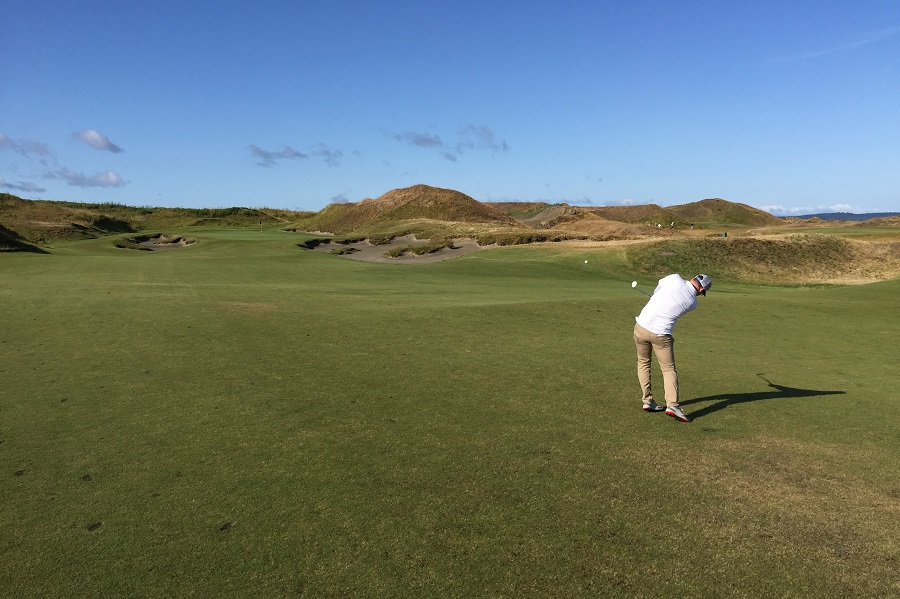
Hopefully you're warmed up by now because the seventh hole (435 yards) is a brute. The long, uphill par 4 demands everything you can muster off the tee, and then it asks for even more on the second, which plays over large grassy hummocks to an oversized green. Don't be short. Anything that doesn't find the putting surface can roll 60 yards back down the fairway. Par here is an accomplishment.
There's not much letup at the eighth hole (523 yards), the third par 5 of the front nine and also the toughest. This three shotter traverses the top of the property, with a pronounced slope from left to right. Favor the left-hand side all the way to the narrow, bunkerless green.
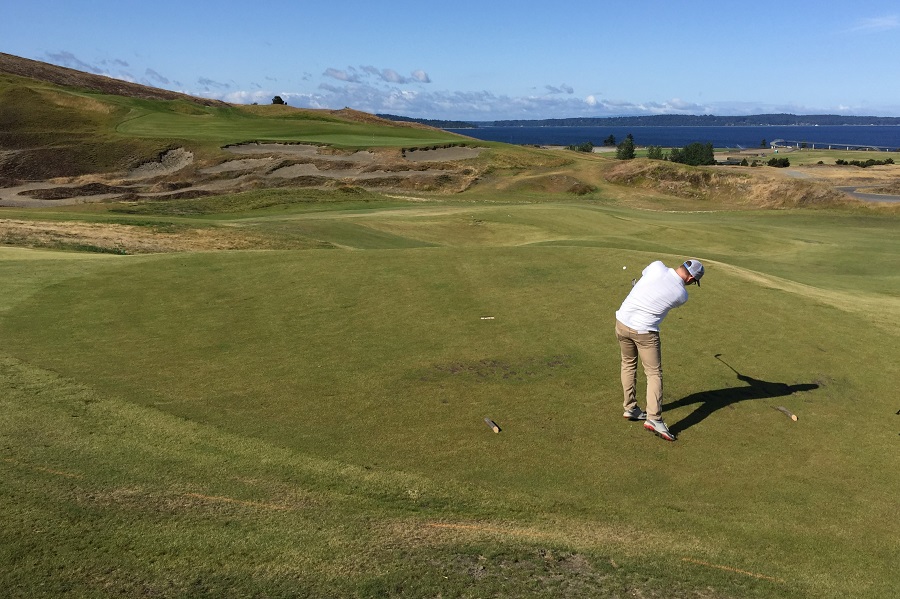
The dramatic par-3 ninth hole (202 yards) plays 100 feet back down the hill to a large green. With deep bunkers short and right, the smart play is out to the left, where a steep bank kicks the ball towards the center of the putting surface.
The tenth hole (360 yards) is one of the prettiest on the course. But don't let its beauty distract you. Though this par 4 looks relatively easy on the card, it plays as one of the inward nine's toughest. A left-of-center tee shot leaves the best angle into the green, which is little more than a small patch of short grass hemmed in by towering dunes. Precision here is key.
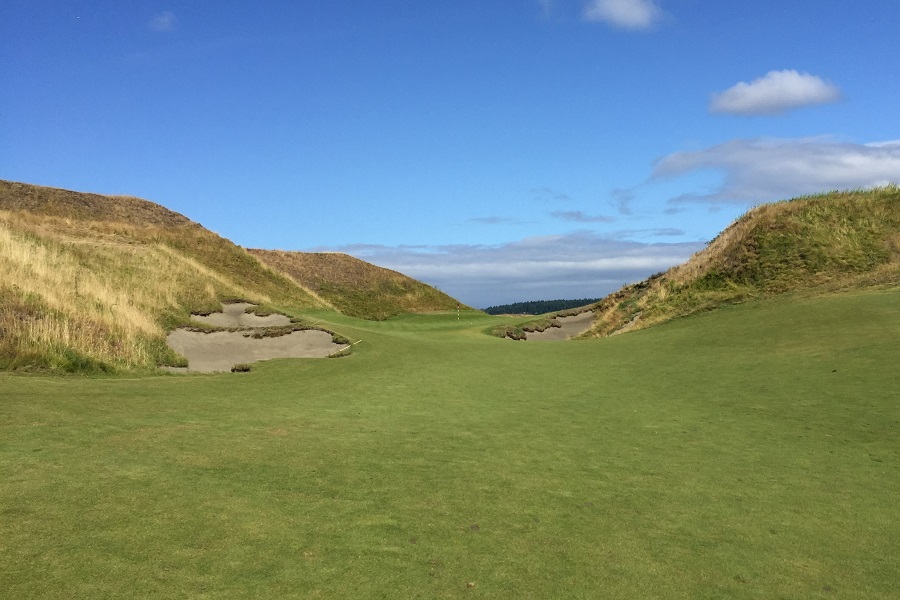
The next two holes provide a bit of a breather. The par-4 eleventh hole (425 yards) calls for a 200-yard carry over the lone dune in the center of the fairway, leaving a fairly simple, if lengthy, approach into a large, undulating green. That's followed by the short twelfth hole (262 yards), a driveable par 4 that plays uphill to a receptive, bowl-shaped green.
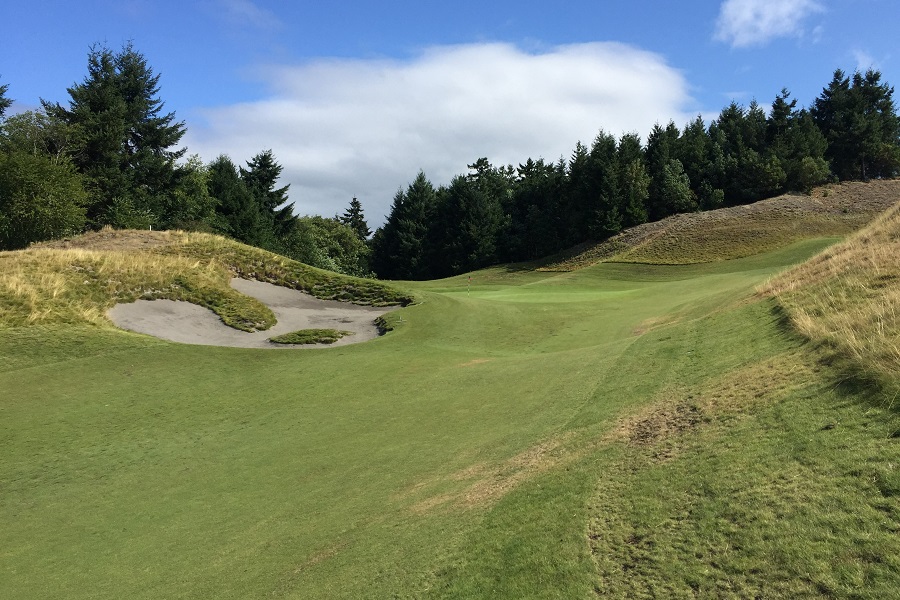
Major challenges return at the par-4 thirteenth hole (453 yards), a lengthy dogleg right playing up the hill at the northeast corner of the property. Favor the right side of the wide fairway to shorten your approach. A large bunker guards the front of the green, so consider clubbing up to ensure you fly it all the way to the putting surface.
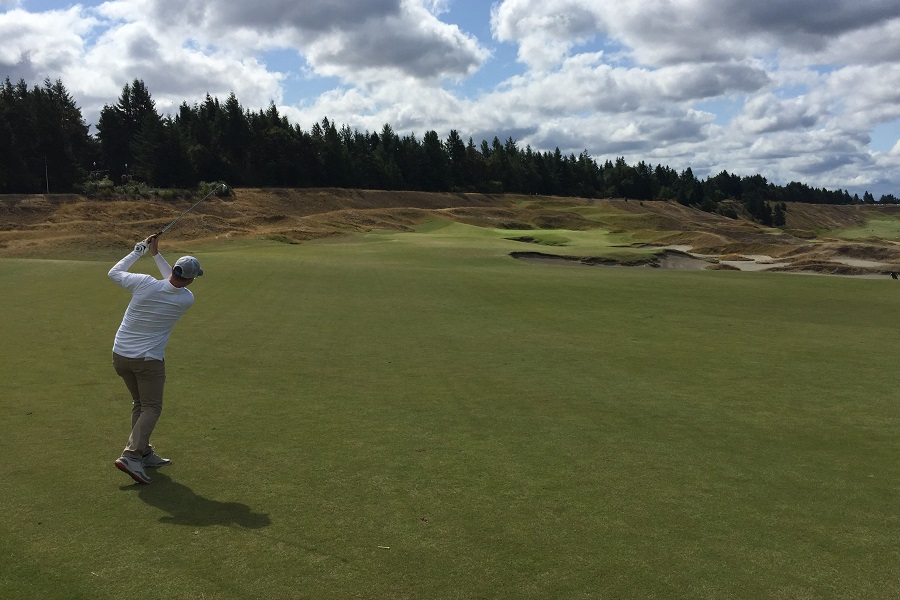
The tee of 407-yard par-4 fourteenth hole is one of the highest points on the course, providing a dramatic launching pad for your drive. Pick your line carefully, though, to avoid the lunar-like waste bunker running the length of the hole's left side. An approach landing short and right of the green should kick onto the surface. However, shots carrying pin high may bound through since the back of the green slopes away.
A string of par 4s is finally broken with the par-3 fifteenth hole (116 yards), which plays as Chambers Bay's easiest. Aptly named Lone Fir (for the scraggly Douglas Fir behind the green — the only tree on the course), the short downhill one-shotter makes for a great photo op. It can also be quite challenging on a windy day.
Don't put the camera away just yet because the round's final par 4 and par 3 both play alongside beautiful Puget Sound. At the 359-yard sixteenth, a left-of-center tee ball sets up the best angle into the small green, which narrows to little more than a sliver at the back. Meanwhile, the 142-yard seventeenth plays over an expansive bunker to a green bisected by a pronounced ridge. If the pin's on the right side, best of luck to you; it takes a gutsy and accurate shot to get it close.
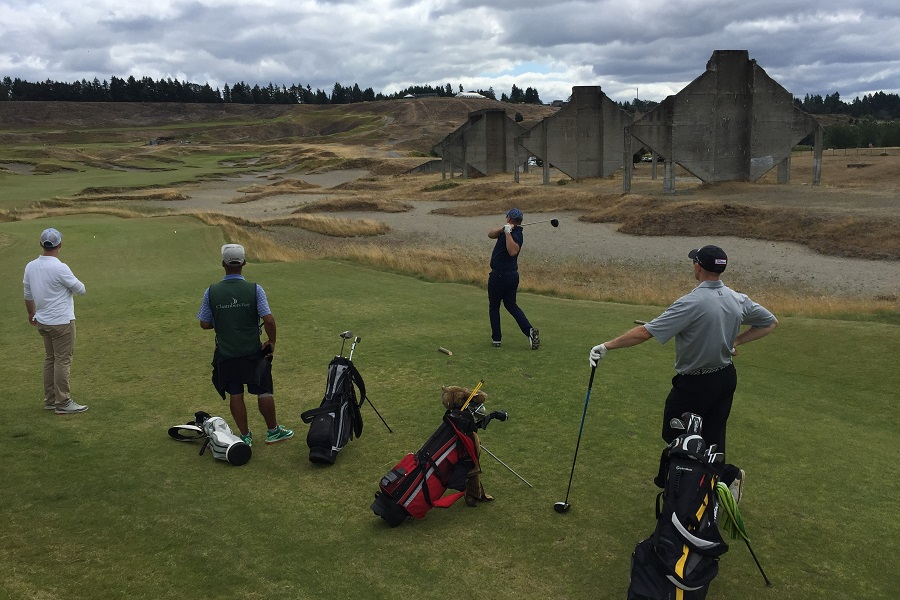
Closing out the round, the par-5 eighteenth (514 yards) offers yet another picture-perfect moment with jagged industrial ruins towering over the teebox. The relatively short home hole offers a birdie chance for those who can navigate the bunkers en route to the green. But you'll still have to earn it with a deft putting game on the large multi-level putting surface.
Conditions & Pace of Play
As a premier public golf course, Chambers Bay has some of the best playing conditions you can expect to find anywhere. But it's important to keep in mind that, as a links course, it does not offer the kind of lush turf that you might be used to, especially if you play regularly in the Pacific Northwest.
Rather, Chambers Bay features hard and fast fairways where the grass is mown tight to the sandy soil. In these conditions, you'll find that good contact requires a crisp downward strike on the golf ball. You'll also find that the ball bounces and runs much more than you might expect.
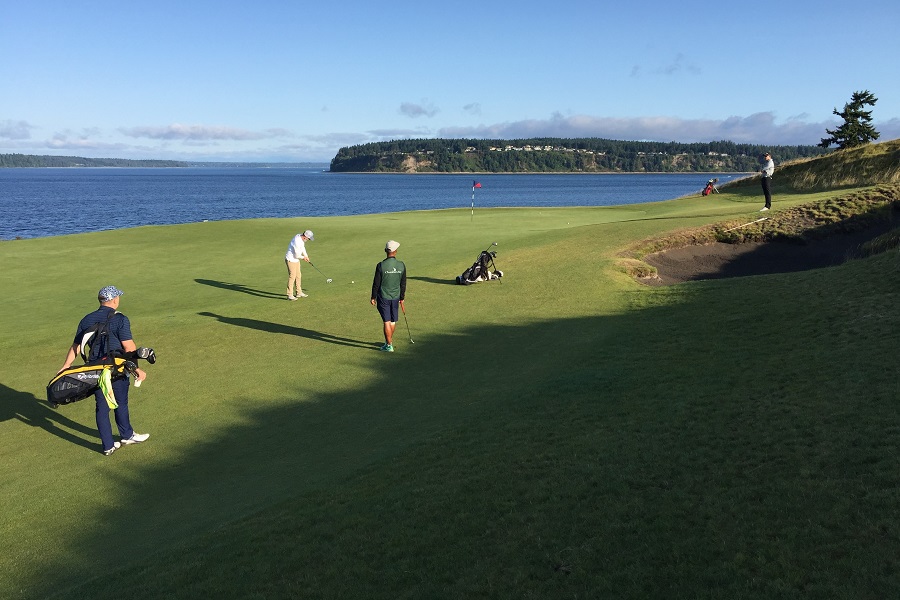
The good news is that this shortens the course significantly. The bad news is that it can bring the course's many bunkers into play more often, as the ball runs out farther than you might anticipate. To get the hang of it, make sure to spend some time warming up on the all-grass practice range, which features the same sort of turf that you can expect on the course.
Chambers Bay somewhat infamously hosted the 2015 U.S. Open. At the time, many players openly criticized its links-style fescue greens, which were suffering under drier-than-normal conditions, making them patchy and bumpy. Billy Horschel, who tied for 25th that week, called them the "worst rolling greens I've ever putted on."
Since then, however, the greenkeeping staff has completely redone all of the greens in native poa annua, which offers a much more consistent playing surface. By all recent accounts, the greens now putt beautifully all year round.
As noted earlier, Chambers Bay is a walking-only course. For players who aren't used to that, the rather hilly terrain can be a challenge. Combine that with the difficulty of some holes, especially those with blind shots, and play can slow to a crawl at times.
We recommend hiring one of the excellent local caddies to help keep your round moving along at a good clip. But if all else fails, you can at least console yourself with the views, which almost never fail to be spectacular.
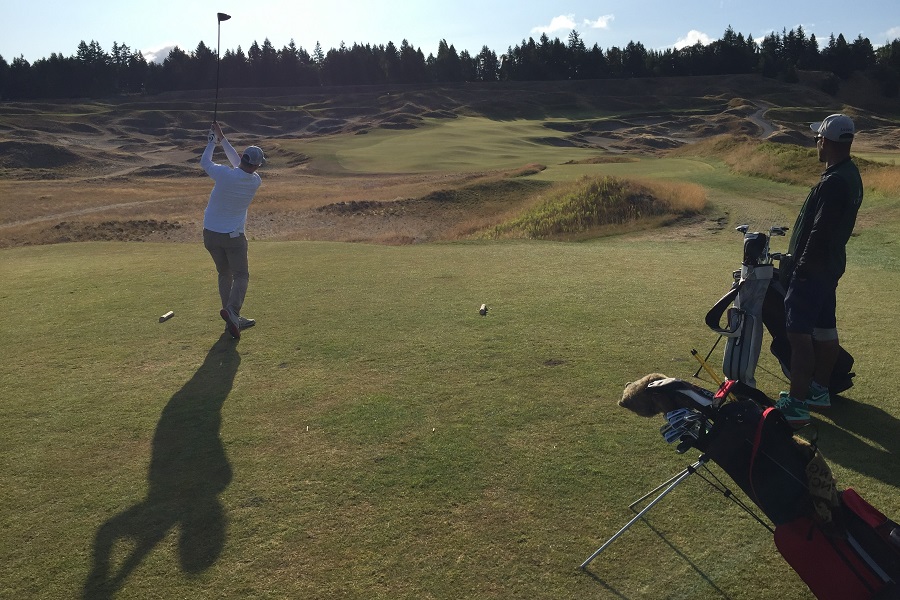
Parting Thoughts
We think Chambers Bay is a must-play golf course. But don't take our word for it. Golf Digest recently ranked it #22 on their annual America's 100 Greatest Public Courses list. They also rate it the #1 course to play, public or private, in the state of Washington.
Few other courses offer such a compelling combination of beauty, drama, and fun — and those that do tend to be private, where Chambers is proudly open to all.
Yes, it's expensive. And yes, you should probably bring your rain gear. But it's worth it. Walking 18 holes at Chambers Bay is an experience most golfers will never forget.
Based in Seattle after a long stint in Southern California, Mark often plays with only even or odd irons and breaks 80 anyway. He has also owned a bunch of classic Mercedes-Benzes, with engines ranging from diesel four-cylinders to a couple of V-12s.
Chambers Bay Golf Course Details
| GG Rating | 9.0/10 |
|---|---|
| Price | $149 - $299 |
| Address | 6320 Grandview Drive West, University Place, WA 98467 |
| Website | Visit |
| Phone | 253-460-4653 |
| Holes | 18 |
| Par | 72 |
| Yardage | 5226 - 7165 |
| Course Rating | 65.3 - 75.6 |
| Slope | 119 - 139 |
| Cart | Not available—walking only |
Chambers Bay Golf Course Photos (13)

Chambers Bay Golf Course: Hole 1 Detail

Chambers Bay Golf Course: Hole 12 Approach

Chambers Bay Golf Course: Hole 1 Tee

Chambers Bay Golf Course: Hole 2 Tee

Chambers Bay Golf Course: Hole 4 Green

Chambers Bay Golf Course: Hole 6 Fairway

Chambers Bay Golf Course: Hole 9 Tee

Chambers Bay Golf Course: Hole 10 Fairway

Chambers Bay Golf Course: Hole 12 Fairway

Chambers Bay Golf Course: Hole 13 Fairway

Chambers Bay Golf Course: Hole 18 Tee

Chambers Bay Golf Course: Hole 2 Green

Chambers Bay Golf Course: Hole 4 Tee
